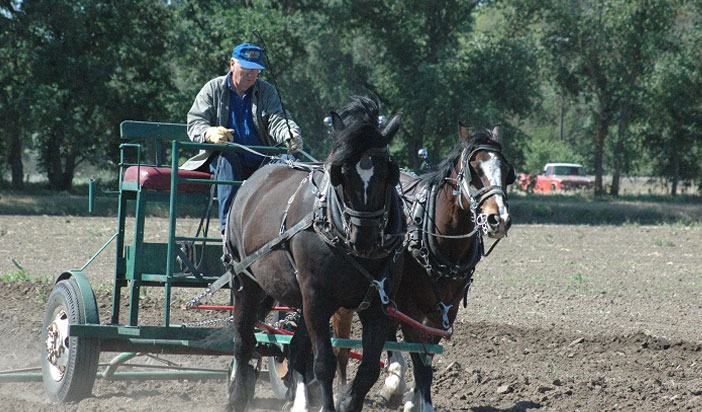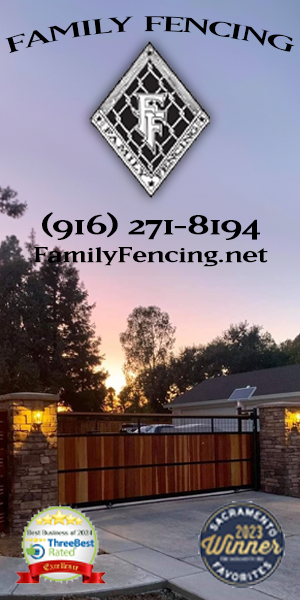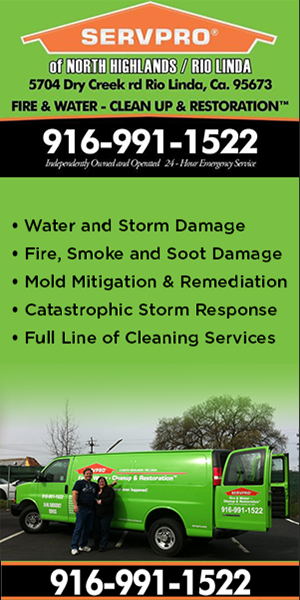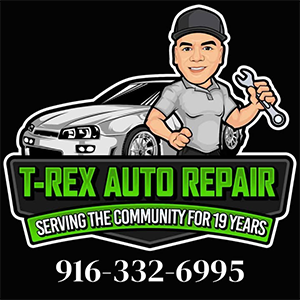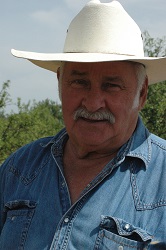 Corning, CA— “Come up!” crooned draft horse teamster Nolan Darnell to Purdy and Pepper, his white ”Molly” mules, directing them to pick up the pace as they briskly marched in tandem down a country lane surrounded by lush olive orchards.
Corning, CA— “Come up!” crooned draft horse teamster Nolan Darnell to Purdy and Pepper, his white ”Molly” mules, directing them to pick up the pace as they briskly marched in tandem down a country lane surrounded by lush olive orchards.
The distinctive crunch of gravel under steel-shod hooves, harness jingling and the vintage rig bouncing along transports one back to earlier times.
“There’s a special type of joy just being around and working with draft horses and mules,” Darnell explained, lightly holding two-sets of leather reins between his fingers, silently communicating through the lines.
Darnell is a nationally recognized Draft Horse Teamster with a lifetime of adventures under his cowboy hat: A 5-year active duty stint in the Marine Corps (his father, Darnell and son, Jess, comprise a Marine Corps dynasty) and former high school youth sports coach, he even survived a 22-year career as a Sargent with the Oakland Police Department.
Darnell holds the Medal of Valor for saving the life of his partner who was shot nine times—and that was moments after Darnell had been shot in the back. “But, we’ll save that story for another chapter,” Quips Darnell.
The World of Driving Heavy Horses
Working horses and mules under harness is a fast growing sport that benefits both young and old equines and their owners. It enhances and strengthens the bond between a driver and the horse, as one learns to communicate using new skills. It is a talent that takes time, patience and a knowledgeable instructor—if you can find one these days.
High on Darnell’s list of accomplishments is teaching people how to drive under harness.
Two of his former students are a husband and wife team, Sid and Tom McBride. Sid said, “Eleven years ago we were just beginning drivers and appreciated all of the knowledge and safety considerations that we learned from Darnell.”
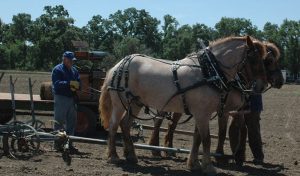 Working around horses weighing in at 1,800 pounds and unusual vintage farm equipment is a blend of art, physics and hard work—with hands-on experience gleaned from years out in the field.
Working around horses weighing in at 1,800 pounds and unusual vintage farm equipment is a blend of art, physics and hard work—with hands-on experience gleaned from years out in the field.
McBride dubs Darnell as, “A teamster supreme. He puts safety first and is always willing to share his knowledge and expertise…as well as being a really good friend to my husband and I.”
If you’ve ever attended the Draft Horse Classic at the Nevada County Fairgrounds, chances are good that you’ve seen Darnell in action, either driving, teaching, demonstrating vintage farm equipment or managing hundreds of exhibitors and spectators.
Sandy Woods, CEO, of the Nevada County Fairgrounds and the Draft Horse Classic said, “Nolan has been an avid exhibitor at the Draft Horse Classic since its inception 29 years ago. He has won many ribbons for his outstanding driving ability. Over the years we have come to rely on Nolan for his leadership in the draft horse community. It is Nolan who provides the exhibitors with guidance and assists with the technical issues, particularly as they relate to safety, in the creation of the annual Draft Horse Classic performances. I think of Nolan as one of the significant anchors in the success of the Draft Horse Classic.”
At the beginning of each Draft Horse Classic performance Nolan drives in the ‘flag wagon.’ “It’s an impressive grand entry in honor of our country and our heritage. I’m always impressed, watching Nolan maneuver the big horses, and I often reflect on how grateful I am to call Nolan Darnell my friend,” states Woods.
But when it gets right down to it, Darnell is a teacher at heart. “I really enjoy helping people learn how to safely drive horses. Some of the kids that I’ve taught will come back as adults and bring their children to the Nevada County Fair and the Draft Horse Classic. I’ve watched a lot of kids grow up appreciating heavy horses and that’s very rewarding.”
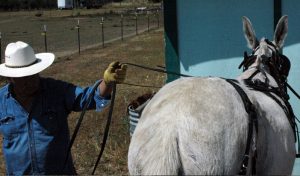 All or Nothing
All or Nothing
In 1984, Darnell had the opportunity to apprentice with legendary teamster, Dale Yearian from Castro Valley, California. “Dale was a really tough task master…but it was all about being safe. Dale’s motto was, ‘Do it right, or don’t do it at all.’
Darnell’s experience spans years of driving horses and mules in singles, pairs and as many as sixteen up—known as driving a multiple. He has mastered driving teams for the Ringling Brothers Circus to nationally recognized events such as the Cattle Drive for the Reno Rodeo.
Woods, who has worked closely with Darnell for twenty years, has a deep respect for the man. “Nolan is a highly skilled horseman with many years of experience with draft horses and mules. To say that Nolan is passionate about draft horses is indeed an understatement. He has devoted many years to training horses, developing an impressive six-horse hitch of English Shires and studying the history of how the draft horse contributed to the development of America.”
As the President and Founder of the Golden State Draft Horse and Mule Association, Darnell’s blue eyes light up as he describes the club and the myriad of activities. “We’re getting ready for our seventh annual Wagon Train in Westwood California, he explained. “It’s a weeklong wagon train loop with up to twelve wagons. It’s a good group of people from all walks of life.”
Club member Sid McBride expounds—“Nolan tirelessly works to put on a one to three-week wagon train each year. He and a couple other club members work very hard setting up these wagon trains and all the logistical issues that are involved in that. We usually travel on old stage coach or immigration trails. Nolan makes sure we learn about the history of the trails we travel—and I’m also grateful for that.”
Feeling Mulish
In 2013, Darnell purchased his first mule team. He now owns four mules: two Jacks (male mules), “Yankee Jim” and “Dodger Blue” and two Molly mules (females), “Purdy” and “Pepper.”
Mules are the product of breeding a female horse (mare) to a male donkey or a Mammoth Jack.
“I didn’t really know anything about mules, but had always admired their presence. One day, I called my friend Harold who was a longtime mule owner and asked him where I could buy a mule team. Harold said he wondered when I’d finally come to my senses.” Darnell said with a wry grin.
A Shire (Draft Horse) owner for many years, Darnell knew that mules presented a new challenge. “I’ve had to learn a lot about mules. You know, the military used them extensively. One experiment entailed putting a howitzer on the back of a mule. That was a failed experiment.”
It’s clear that he and his four mules have developed a strong bond. “Mules have to learn to trust you first,” said Darnell. “And they never forget things, so always be careful what you’re doing. Mules won’t run through fences like a horse might. If they get caught, they will lay there and figure it out or wait for someone to help them. They won’t eat themselves to death like horses…they are pretty good that way,” Observed Darnell.
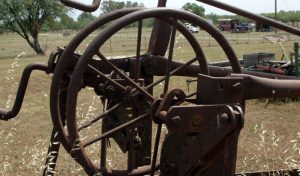 History in Motion
History in Motion
An enthusiastic collector of vintage farm equipment requiring horsepower to make it work, Darnell spends some of his time restoring antique farm pieces that he likes demonstrate. He’s currently refurbishing a circa 1900 Studebaker Freight Wagon and has restored several “Fresnos”—an important piece of equipment used to move large quantities of dirt via horses or mules beginning in the 1920’s.
“You can see tractors every day working in the field—red, green or orange ones. You don’t know if it’s a new one or an old one. But horses take it back further and it’s a big draw. It’s not something you see every day. It’s important to know that things from our past are still worth doing,” states Darnell.
McBride agrees. “One of our favorite things over the years is that we have learned—and are fortunate—to be able to have worked with Nolan on all of the different horse-drawn farm implements…and doing the demonstrations with these implements that both him and our family have collected. That’s the kind of knowledge that can get lost in history and I really appreciate being a part of that.”
Wood praises Darnell’s diverse talents and interests, stating, “While he can drive a powerful six horse hitch with impressive ability, he’s equally comfortable performing with antique farm equipment and explaining the intricacies of driving horses with the fascinating equipment.”
A friendly, but humble man, Darnell thinks that if he’s helped people from getting hurt and learning how to safely work around heavy horses and mules, then “it’s made my twenty-plus journey doing this worthwhile.” he said.
“I’ll keep on enjoying driving until the day I die. In fact, I’ll have somebody throw a set of lines in my casket with me—just in case,” Smiles Darnell, summing up his hobby.
By Candace Lampe-Taylor

